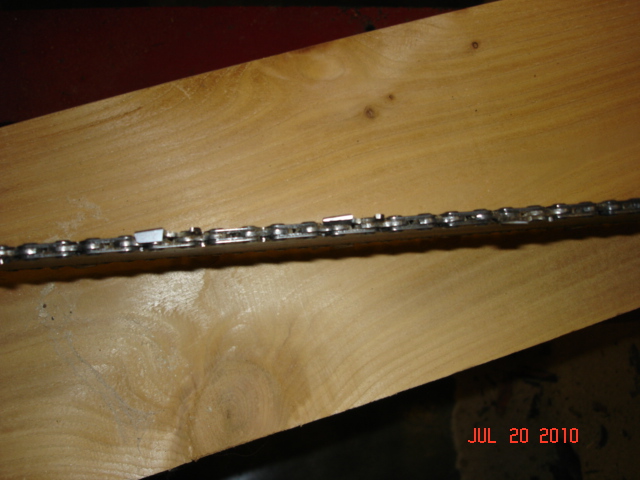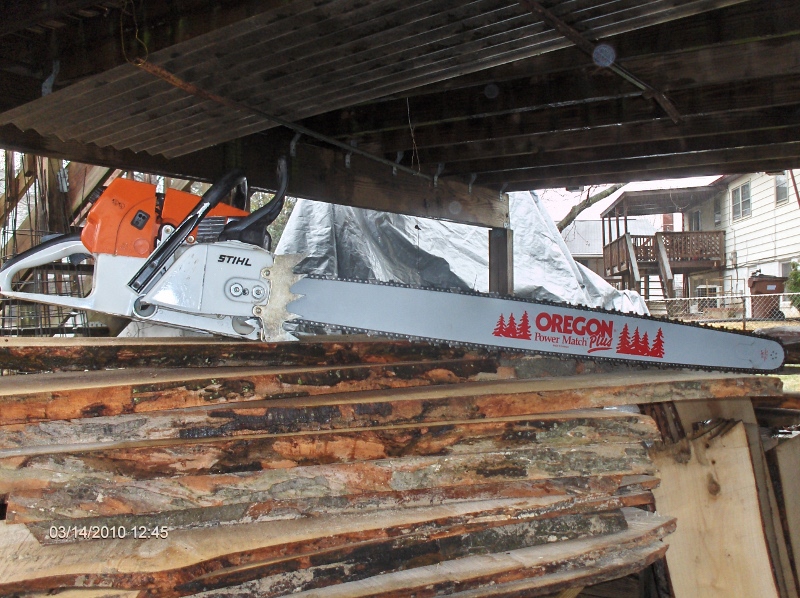Question
What is the best way to "rip logs" for later turning? Do I need to put a different angle on the chain saw chain? I can get sliver or very fine dust what is better?
Forum Responses
(Sawing and Drying Forum)
From contributor J:
When I have to rip 4, 5 and 6 diameter logs I use a chipper tooth chain with 10 degrees on the angle for the cutters not 30 degrees as normal. Granberg is the company that I started using 25 years ago for the chains. The chains used for ripping are not to be used for cross cutting. They do work but very slow. I have two Husky 3120xp saws and have ripped 200 plus logs in the last 10 years and found that the chains are expensive to buy so I make my own up from 100 foot rolls. For ripping big logs you really need a "BIG" saw. The 3120 can use up to a 72" bar on the newer EPA saws, (8.7hp) and on the other older one I have, (9.2hp) it should be able to take a 96" bar. I am working towards converting the EPA saw I have to the older design. It costs more than $400.00 to do. I think it will be worth it down the road.
Back to the chain, I do not use a skip tooth or chisel tooth chain, which means I use a full comp chain with the rounded corners on the teeth. I take a die grinder and remove just the top flat part of every two teeth. This might not make sense so this is where Granberg comes in to see what you need to do. The bar I use the most is 42Ē long and has 123 drivers and after the ends are joined together I set up the die grinder and start at the joint. I first two teeth are left alone (a right and left), the next two teeth the top places are removed (a right and left). The reason for this is to help clean out the cut and help from clogging up the saw. You do leave the sides of the teeth on. You repeat this process until you come back to the start. I hope this helps.
Contributor J - since you grind off the teeth anyway, why don't you just use a skip-tooth chain? I've thought about that for a while but never bought any.
Skip chain doesn't have that portion of the gullet sticking up, it just has a drive link where the cutter would have been, so that's usable space that isn't being utilized other than holding the chain together, which is somewhat important of course. All those cleaners equal less friction, less heat, less wear and tear, and better efficiency - well, you get the idea.
I have always bought bailey's ripping chain for my chainsaw mill, but I'm not really happy with them, The rakers are shaped weird, the rakers are also typically too low from the factory, and I always find teeth of different sharpened lengths. After I regrind each tooth and adjust the rakers the chains cut well, but when I compare them to my typical 24" loops of Husqvarna .058 square chisel chain which I mostly run while logging and crosscuting these ripping chains are horrible! I have been considering buying a roll of my .058 Husqvarna square chisel chain and modifying it to 10 degrees or so and seeing how it works.
I have always found square chisel to cut much faster than round chisel chain, and would like to hear anybodies comments regarding the two types. My chainsaw dealer says the round over chain is basically designed more for the home owner individual and the edge holds up longer from dulling, and the square edge if more for an everyday chainsaw user and cuts quicker, but dulls more easily.
I do not quite understand this and feel that if you hit something in the log, or some sand or grit that the chain will dull equally as fast on both, but I defiantly feel that square chisel cuts faster.

Chisel teeth are very temperamental as to size, shape and depth of the rakers. Chipper teeth are very forgiving and the teeth do not have to have the same size. I can file one side more than the other sometimes and it always cuts straight. I have sharpened hundreds, if not thousands of chains over the last forty years and have only had just a few that just did not work. That was usually from broken teeth from all on one side of the chain
I have never cut myself and can only remember one time I broke a chain. Every chainsaw I have has had the chain brake assembly and falling dogs removed. Believe or not this is for safety and longer life of the clutch drum. People rely way too much on falling dogs and I have found that they should never be installed on any saw unless you fall trees for a living. This is why you need the chain brake. I do not get the bar close to my body and always use both hand and never have my body inline with the bar when cross cutting logs. I am an OSHA instructor and teach safety classes at the community college. Not for chain sawing but for construction sites and the tools used there.

To answer your question you will be able to cut your 6 foot log it will just take longer. By the way, I donít like Stihl saws. I have used them in logging competitions for many years and I just do not like them. Echo saws are just as good at half the price. They do not make a real big saw so I now have two 3120XPís. My newer 3120 has now been converted to the older model with 9.2 HP. It really works greaat!